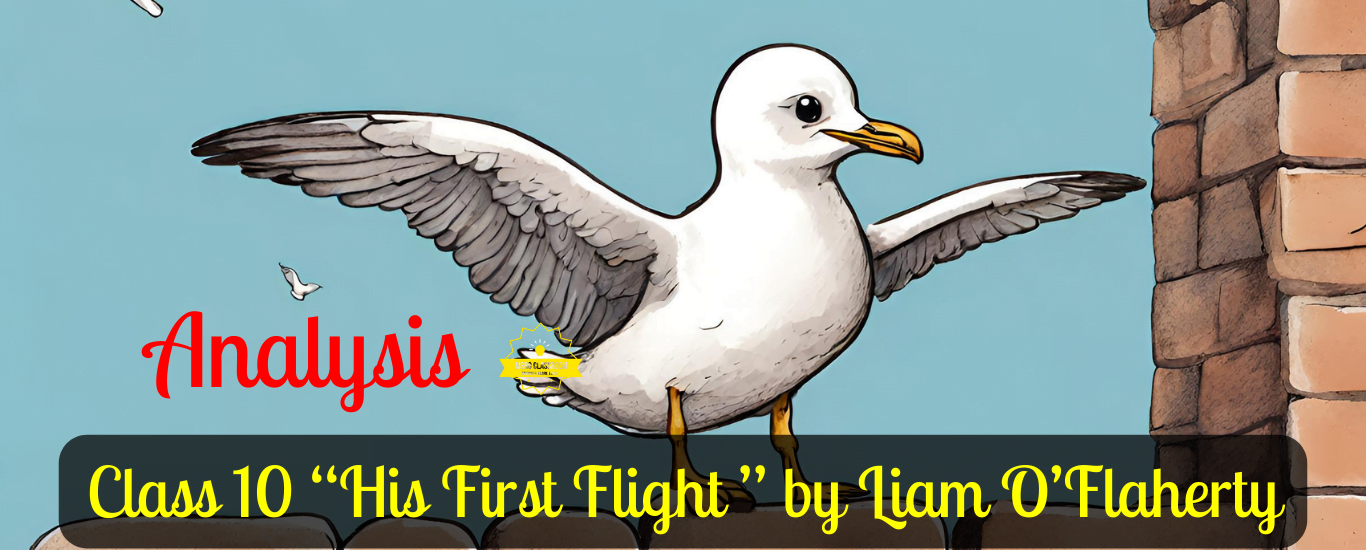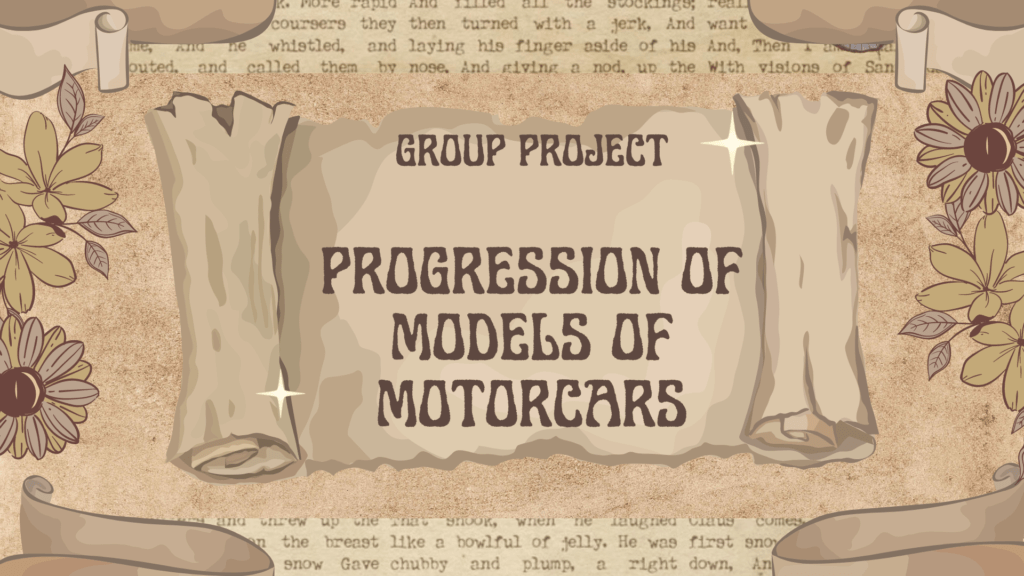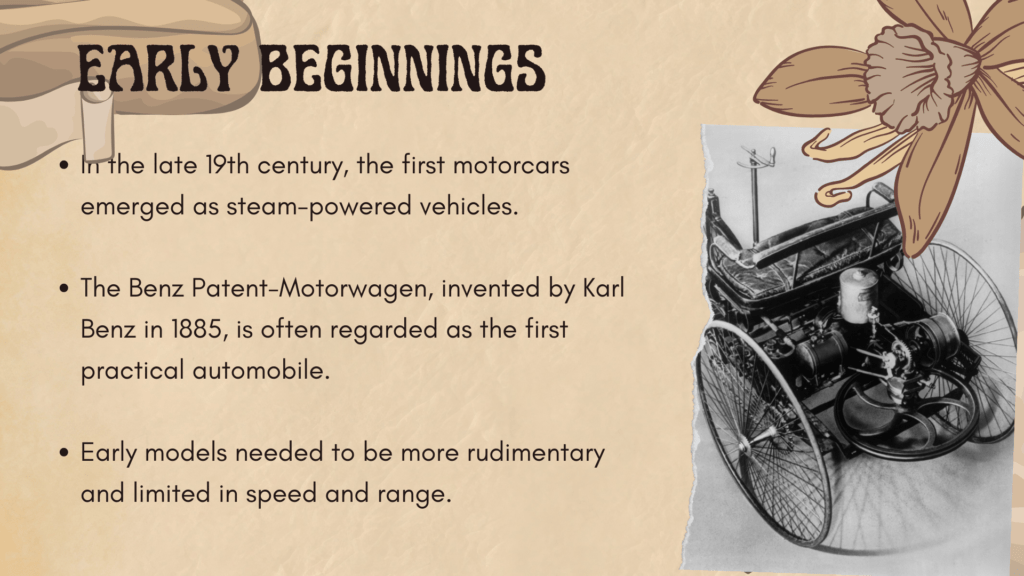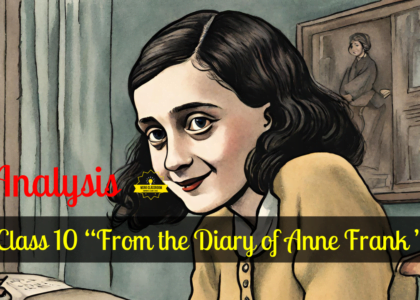Chapter 3, “Two Stories About Flying-His First Flight” Summary, Important Passages, Theme, Questions Answers and Textbook Exercises.
Chapter 3- Two Stories About Flying
Story 1- “His First Flight” by Liam O’ Flaherty:
Table of Contents
Next: Story 2 “Black Aeroplane” by Frederick Forsyth, “How To Tell Wild Animals” by Carolyn Wells
Vocabulary:
- Amusedly – in a manner indicating enjoyment or amusement.
- Banking – tilting sideways during flight, often to change direction.
- Commended – to praise formally or officially.
- Curveting – leaping or prancing in a playful or lively manner.
- Desperate- feeling or showing a hopeless sense that a situation is so bad that it is impossible to deal with.
- Derisively – mockingly or scornfully.
- Dived – to plunge headfirst into water or downward through the air.
- Dog-fish – a small, bottom-dwelling shark, or a name sometimes used for other fish species.
- Expanse – a wide continuous area or stretch.
- Ledge – a narrow horizontal surface projecting from a wall or cliff.
- Motionless – without movement; stationary.
- Plaintively – in a manner that expresses sadness or melancholy.
- Plunge – to jump or dive quickly and energetically.
- Preening – cleaning and arranging feathers with the beak or bill.
- Ridges – long, narrow elevations of land or water.
- Shrieking – making a loud, high-pitched cry or sound.
- Soaring – flying or rising high in the air.
- Taunting – provoking or teasing in a mocking or insulting manner.
- Upbraiding – scolding or criticising severely.
Summary “His First Flight”:
In “His First Flight” by Liam O’Flaherty, a young seagull, initially afraid to fly, overcomes his hunger-driven fear. Begging for food, he accidentally falls off the ledge but discovers he can fly. Initially dizzy, he gradually gains confidence, joining his family in flight.
However, exhausted and weak from hunger, he struggles to land on the sea but ultimately succeeds, floating on it. His family celebrates his achievement, offering him food. This experience marks his first successful flight, overcoming his initial fear and embracing his newfound ability.
Theme:
Overcoming Fear in ‘His First Flight’:
Liam O’Flaherty’s “His First Flight” theme concerns overcoming fear and discovering one’s abilities through courage and determination. The story follows a young seagull who initially struggles with anxiety and hesitation when flying but eventually finds the courage to take his first flight. Through this experience, he learns to trust himself and his capabilities, overcoming his initial doubts and fears.
Further, the story touches upon themes of parental guidance and encouragement, as the young seagull’s family plays a crucial role in supporting him and teaching him how to fly. The story emphasises the importance of facing challenges, embracing new experiences, and ultimately finding strength and confidence.
Important Lines/ Passages:
1. “His two brothers and his sister had already flown away the day before.” The statement indicates that the protagonist (young seagull) is now alone on the ledge, separated from his siblings, who successfully flew away the day before. This sets the stage for the protagonist’s internal struggle with fear and self-doubt.
2. “He felt certain that his wings would never support him; so he bent his head and ran away back to the little hole under the ledge where he slept at night.” This reveals the protagonist’s initial lack of confidence in his flying abilities, leading him to retreat to safety rather than confront his fear. It underscores the psychological barrier he faces in learning to fly.
3. “His father and mother had come around calling to him shrilly, upbraiding him, threatening to let him starve on his ledge unless he flew away.” It shows the parental pressure exerted on the protagonist, emphasising his urgency to overcome his fear and join the rest of the family. The parents’ harsh tactics reflect their concern for his well-being and highlight his challenges.
4. “He had, in fact, seen his older brother catch his first herring and devour it, standing on a rock, while his parents circled around raising a proud cackle.” This description illustrates the protagonist’s observations of his siblings’ successful flights and accomplishments, inspiring and intimidating him. It accentuates his sense of inferiority and reluctance to take flight.
5. “He stepped slowly out to the brink of the ledge… He saw his two brothers and his sister lying on the plateau dozing with their heads sunk into their necks.” This moment marks a critical turning point in the story as the protagonist gathers the courage to confront his fear and attempt flight. It highlights the protagonist’s internal struggle and the contrast between his hesitation and his siblings’ apparent ease with flying.
6. “He leaned out eagerly, tapping the rock with his feet, trying to get nearer to her as she flew across.” This line depicts the protagonist’s eagerness and desperation as he tries to reach his mother, who is flying towards him with food. His tapping on the rock with his feet symbolises his longing for nourishment and reassurance, showcasing his willingness to overcome his fear momentarily.
7. “With a loud scream he fell outwards and downwards into space.” This moment marks the story’s climax, where the protagonist, overcome by hunger and desperation, finally takes the plunge to fly. The scream indicates his initial terror as he falls from the ledge, symbolising his leap of faith and overcoming his fear of flying.
8. “The next moment he felt his wings spread outwards.” Immediately after falling, the protagonist experiences a pivotal moment of realisation and empowerment as he feels his wings spreading outwards. This symbolises his automatic response to the danger of falling, demonstrating his innate ability to fly and survive.
9. “He was soaring gradually downwards and outwards. He was no longer afraid.” As the protagonist begins to glide downwards and outwards, he experiences a shift in perspective and emotion. The gradual descent represents his newfound confidence and courage, contrasting sharply with his earlier fear and hesitation. This transformation highlights his triumph over adversity and his embrace of the exhilarating freedom of flight.
10. “He was near the sea now, flying straight over it, facing straight out over the ocean.” This line marks the protagonist’s achievement of a significant milestone in his flight journey. As he flies near the sea, facing the vast expanse of the ocean below, he experiences a sense of awe and wonder. It symbolises his exploration of new horizons and his newfound mastery of the skies, signalling his successful integration into the world of flying seagulls.
11. “His parents and his brothers and sister had landed on this green flooring ahead of him. They were beckoning to him, calling shrilly.” This line describes the protagonist’s family members landing on a green surface ahead of him, likely a patch of seaweed floating on the ocean. Their beckoning and shrill calls indicate their encouragement and excitement for him to join them. It symbolises a moment of acceptance and celebration within the family, marking the completion of his first flight.
12. “His legs sank into it. He screamed with fright and attempted to rise again flapping his wings.” After attempting to land on the green surface, the protagonist’s legs sink into it, causing him to panic and scream in fright. His instinctual reaction is to try to rise again by flapping his wings, showcasing his determination and resilience in the face of unexpected challenges.
13. “He was floating on it, and around him his family was screaming, praising him and their beaks were offering him scraps of dog-fish.” Despite his initial fear and struggle, the protagonist finds himself floating on the green surface, supported by the buoyancy of the seaweed. Around him, his family members show him praise and offer him food, symbolising their pride and support for his achievement. This moment represents a culmination of his efforts and marks his successful transition from a fledgling to a fully-fledged seagull.
14. “He had made his first flight.” This line succinctly captures the culmination of the protagonist’s journey – his first successful flight. It symbolises his triumph over fear and his embrace of his innate abilities. It also signifies a significant milestone in his development as a seagull, marking the beginning of his adventures and growth into the broader world.
Questions Answers “His First Flight”:
Thinking About The Text:
Q1: Why was the young seagull afraid to fly? Do you think all young birds are afraid to make their first flight, or are some birds more timid than others? Do you think a human baby also finds it a challenge to take its first steps?
A1: The young seagull was afraid to fly due to his fear of falling and lack of confidence in his wings supporting him. While fear of flying is common among young birds, not all birds may experience the same level of timidity.
Some birds may be more naturally cautious or hesitant than others, just as some humans may be more timid or cautious in trying new things. Similarly, human babies often find it challenging to take their first steps due to fear of falling or uncertainty about their abilities, mirroring the young seagull’s experience.
Q2: “The sight of the food maddened him.” What does this suggest? What compelled the young seagull to finally fly?
A2: The statement “The sight of the food maddened him” suggests that hunger and the desire for food were powerful motivators for the young seagull. His intense hunger compelled him to overcome his fear and finally attempt to fly, driven by the instinctual need for nourishment.
Q3: “They were beckoning to him, calling shrilly.” Why did the seagull’s father and mother threaten him and cajole him to fly?
A3: The seagull’s parents threatened and cajoled him to fly out of concern for his well-being and his need to learn essential survival skills. Flying is crucial for a seagull’s survival, allowing them to find food and evade predators.
By pressuring the young seagull to fly, the parents attempted to encourage him to overcome his fear and develop the necessary skills to thrive in the wild.
Q4: Have you ever had a similar experience, where your parents encouraged you to do something that you were too scared to try? Discuss this in pairs or groups.
A4: Yes, I remember vividly when my parents encouraged me to participate in a school debate competition. The mere thought of speaking in front of an audience filled me with dread. Despite my fear, my parents assured me of their support and the importance of facing challenges head-on. With their encouragement, I reluctantly agreed to participate.
The experience was nerve-wracking, but I pushed through, drawing strength from my parents’ belief in me. Though I didn’t win the competition, I gained confidence and public speaking skills. It was a daunting experience that taught me how to overcome fear with support and determination.
Q5: In the case of a bird flying, it seems a natural act, and a foregone conclusion that it should succeed. In the examples you have given in answer to the previous question, was your success guaranteed, or was it important for you to try, regardless of a possibility of failure?
A5: In my experience with public speaking, success was not guaranteed, and failure was a distinct possibility. However, I needed to try regardless of the potential for failure.
While flying may come naturally to birds, public speaking only comes naturally to some, myself included. The fear of failure was daunting, but the opportunity for personal growth and development outweighed the risk.
Trying allowed me to confront my fears, build resilience, and develop essential skills. Ultimately, even if I hadn’t succeeded, trying was valuable in itself, as it pushed me out of my comfort zone and contributed to my growth as an individual.
Speaking:
We have just read about the first flight of a young seagull. Your teacher will now divide the class into groups. Each group will work on one of the following topics. Prepare a presentation with your group members and then present it to the class.
• Progression of Models of Airplanes
• Progression of Models of Motorcars
• Birds and Their Wing Span
• Migratory Birds — Tracing Their Flights
Sample: Group Project
Writing:
Write a short composition on your initial attempts at learning a skill. You could describe the challenges of learning to ride a bicycle or learning to swim. Make it as humorous as possible.
What students should keep in mind before attempting this exercise.
1. Audience Awareness: Consider your audience – in this case, your classmates or readers – and tailor your composition to entertain and engage them.
2. Humour Appropriateness: Ensure your humour is appropriate and light-hearted, avoiding offensive or sensitive topics.
3. Personal Anecdotes: Draw from personal experiences and anecdotes to make your composition relatable and authentic.
4. Language Proficiency: Showcase your English proficiency using various vocabulary and sentence structures while maintaining clarity.
5. Emotional Tone: Balance humour with sincerity and vulnerability to create a compelling narrative that resonates with the audience.
6. Organisation: Structure your composition with a clear introduction, body paragraphs, and conclusion to maintain coherence and flow.
7. Revision and Editing: Review and revise your composition to refine your ideas, eliminate unnecessary details, and ensure coherence and effectiveness.
8. Length Consideration: Keep your composition concise and focused, adhering to any length requirements specified in the question prompt.
Sample:
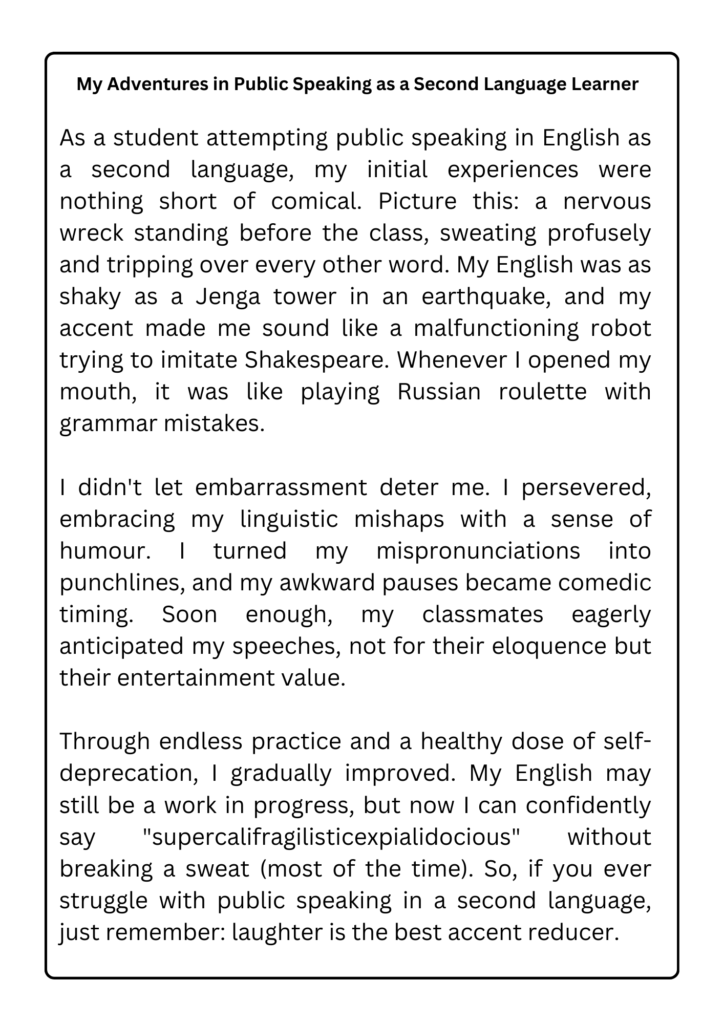
Extra Questions “His First Flight”:
Short Answer Type Questions:
Q1: Who is the protagonist of the story?
A1: The protagonist is a young seagull depicted as timid and fearful compared to his siblings. He struggles with flying and lacks the confidence to leap from the ledge.
Q2: What motivates the young seagull to attempt flying finally?
A2: The young seagull’s primary motivation to attempt flying stems from his hunger. Despite his fear and hesitation, the sight of his family enjoying food triggers his instinctual drive to feed himself, compelling him to overcome his apprehension and try flying.
Q3: How does the young seagull overcome his fear of flying?
A3: The young seagull inadvertently overcomes his fear when he falls off the ledge while reaching for a piece of fish his mother offers. Initially gripped by terror as he plummets, he soon discovers his ability to fly, realising that his wings can support him.
Q4: What challenges does the young seagull face during his first flight?
A4: During his first flight, the young seagull encounters several challenges. First, he struggles with exhaustion and weakness due to hunger, making it difficult to maintain his flight. Additionally, he finds it challenging to land correctly on the water’s surface, as he is not accustomed to the sensation of floating.
Q5: How does the story end?
A5: The story concludes with the young seagull floating on the water’s surface, surrounded by his family. Despite his initial struggles and fears, his family members praise and encourage him, signifying his successful initiation into the world of flight and his acceptance within the seagull community.
Q6: What emotions does the young seagull experience as he contemplates flying?
A6: The young seagull experiences fear, uncertainty, and longing. He fears the vast expanse beneath him and doubts his ability to fly, yet he yearns to join his family in the skies.
Q7: How do the young seagull’s parents and siblings initially react to his reluctance to fly?
A7: Initially, the young seagull’s parents and siblings encourage him to fly by calling him and offering guidance. However, as time passes and he remains hesitant, they resort to taunting and threatening him.
Q8: Describe the young seagull’s first moments of flight.
A8: The young seagull’s first moments of flight are a mixture of terror and exhilaration. After accidentally falling from the ledge, he experiences a brief moment of panic before realising that he can control his descent and soar through the air.
Q9: What significance does the green sea hold for the young seagull?
A9: The green sea is a source of fear and fascination for the young seagull. Initially terrified when he lands on it, he eventually learns to float and is intrigued by its vastness and movement.
Q10: How does the young seagull’s perception of himself change after his first flight?
A10: After his successful first flight, the young seagull gains confidence and a sense of accomplishment. He sheds his earlier self-doubt and fully embraces his identity as a capable flyer, eager to explore the skies and the world beyond.
Long Answer Type Questions:
Q1: What was the young seagull’s initial fear about flying?
A1: The young seagull’s initial fear of flying stemmed from a deep sense of insecurity and doubt regarding his abilities. He was afraid that his wings wouldn’t support him and that he would plummet down into the vast expanse of the sea below. Despite witnessing his siblings and parents flying effortlessly, he couldn’t muster the courage to plunge.
The great distance to the sea below filled him with terror, making him retreat to the safety of his ledge. This fear of failure and the unknown consequences of flight paralysed him, keeping him grounded while his family soared above, taunting him with his perceived cowardice.
Q2: How did the seagull’s family try to encourage him to fly?
A2: The seagull’s family tried to encourage him to fly by employing various methods of persuasion and demonstration. They attempted to teach him flight skills by example, demonstrating graceful manoeuvres and providing practical lessons. His parents and siblings flew around him, showcasing their abilities and honing their skills in his presence.
They also encouraged him, calling him shrilly, urging him to join them in the sky. Despite their efforts, the young seagull remained hesitant and fearful, unable to overcome his doubts and take the leap into flight. Ultimately, the combination of hunger and the tempting sight of food motivated him to overcome his fears and make his first flight.
Q3: Describe the moment when the young seagull finally took flight.
A3: The moment when the young seagull finally took flight was characterised by a sudden surge of adrenaline and determination. After prolonged hesitation and fear, hunger drove him to the brink of desperation. Seeing his mother flying across with a piece of fish, he leaned out eagerly, tapping the rock with his feet, trying to get closer to her.
But as she hovered opposite him, holding the food just out of reach, he dived impulsively, driven by his intense hunger. Initially, terror gripped him as he fell outward and downward into space, his heart standing still.
However, his instinct kicked in within moments, and his wings spread outwards, catching the wind. The sensation of flight replaced his fear, and he soared gradually downward and outward, finally overcoming his fear and embracing the freedom of flight.
Q4: What were the seagull’s initial sensations when he started flying? Or What physical sensations did the seagull experience during his first flight?
A4: The seagull’s initial sensations when he started flying were a mixture of terror, exhilaration, and disorientation. Initially, as he leapt into the air, terror gripped him as he felt himself falling outward and downward into the vast expanse below.
His heart stood still with fear, and for a moment, he could hear nothing but the rush of wind. However, this terror was swiftly replaced by exhilaration as he felt his wings spread outwards and caught the wind, allowing him to soar gradually downward and outward.
Despite feeling a bit dizzy at first, the thrill of flight overcame his initial fear, and he found himself embracing the sensation of freedom and weightlessness that flying provided.
Q5: What did the seagull see as he flew over the ocean?
A5: As the seagull flew over the ocean, he saw a vast expanse of green sea beneath him, with little ridges moving over it. The ocean stretched before him, extending to the horizon in all directions.
From his aerial vantage point, he observed the waves’ rhythmic movement and the water’s changing hues below. The sunlight danced upon the surface, creating sparkling patterns that mesmerised him.
The seagull turned his beak sideways and cawed amusedly, revelling in the beauty and vastness of the ocean beneath him. This breathtaking sight further reinforced his sense of freedom and adventure as he soared effortlessly through the open sky.
Q6: Why did the seagull struggle when he attempted to land on the “green sea”?
A6: The seagull struggled to land on the “green sea” because it was not water but a vast expanse of seaweed-covered rocks. Initially, the seagull mistook it for water due to its green colour and the movement of little ridges over it.
However, as he attempted to land, he realised his mistake when his legs sank into the seaweed-covered rocks. This unexpected resistance caught him off guard, causing him to panic and struggle to rise again.
In spite of his efforts to flap his wings and lift off, he was tired and weak from hunger, making it difficult for him to regain altitude. Thus, he found himself floating on the seaweed-covered rocks, exhausted and unable to fly away immediately.
Q7: How did the seagull’s family react to his successful flight?
A7: The seagull’s family reacted to his successful flight with excitement, pride, and encouragement. Upon witnessing the young seagull’s successful flight, his family members, including his parents and siblings, screamed with delight and praised him loudly.
They circled him, beckoning to him and calling shrilly, indicating their joy and approval of his accomplishment. They offered him scraps of dogfish to reward his bravery and determination.
Their enthusiastic reaction reinforced the young seagull’s sense of achievement and belonging within the family unit, affirming his newfound ability to fly and participate fully in their communal activities.
Q8: How did hunger affect the seagull’s ability to fly?
A8: Hunger significantly affected the seagull’s ability to fly, weakening his physical strength and stamina. The seagull had not eaten since the previous nightfall, leaving him exhausted and depleted of energy.
As he attempted to take flight, the effects of hunger manifested, making it difficult for him to sustain his efforts. Despite his determination to overcome his fear and join his family in flight, the seagull struggled against the combined forces of hunger and fatigue.
These factors compromised his ability to maintain altitude and control his flight, causing him to experience difficulties in landing and staying airborne. Thus, hunger acted as a formidable obstacle, hindering the seagull’s initial attempts at flight until he could satisfy his hunger and regain his strength.
Q9: What emotions did the seagull experience as he floated on the “green sea” after landing?
A9: After landing, the seagull floated on the “green sea” and experienced a mixture of emotions, including relief, curiosity, and perhaps a lingering sense of apprehension. Relief washed over him as he realised he had successfully landed and was no longer in immediate danger.
A sense of curiosity accompanied this feeling as he observed his surroundings and realised that the “green sea” was a bed of seaweed-covered rocks. However, there may have also been a lingering sense of apprehension or uncertainty about his situation, as he could not retake the flight due to exhaustion immediately.
Despite this, the experience likely left him feeling triumphant and empowered, overcoming his fear of flying and successfully joining his family in the open sky.
*****

